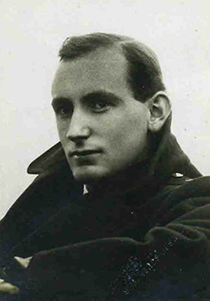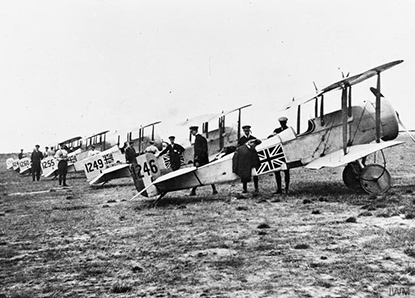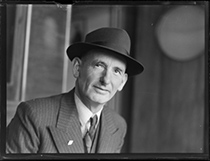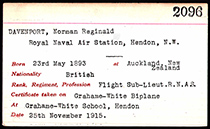
Davenport’s Royal Aero Club index card shows that he qualified as a pilot on a Grahame-White Biplane.Image kindly provided by the Royal Aero Club Trust.
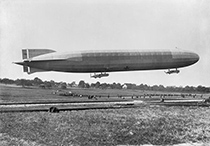
The Royal Navy Air Service defended Britain from German aircraft and Zeppelins, such as this one which raided eastern England in 1915. It was shot down by anti-aircraft fire over Revigny, France on 21 February 1916. © Imperial War Museums (Q 58481)
Learning to fly
In 1915, flying was still a new and exciting pastime and aeroplanes a rarity, especially in New Zealand. Perhaps Davenport had been entranced by the sight of the Bleriot monoplane, Britannia, which flew over Auckland early 1914 or seen local aviation pioneers Leo and Vivian Walsh launch their Curtiss flying boat near Bastion Point? This is just speculation but Davenport was obviously keen to learn how to fly, which until the establishment of the New Zealand Flying School in late 1915 meant a self-funded trip to Britain.
In Britain, however, the military had been investigating the use of captive balloons, kites, dirigibles and aeroplanes for reconnaissance and had established the Royal Flying Corps (RFC) by Royal Warrant in April 1912. At first the Corps comprised a Military Wing, a Naval Wing and a Central Flying School, funded jointly by the War Office and the Admiralty but in July 1914 the smaller Naval Wing became a separate entity and was renamed the Royal Navy Air Service (RNAS). From September 1915, the RNAS was assigned responsibility for British air defence and would play an important role in preventing attacks by German aircraft and airships known as Zeppelins.
Davenport’s progress towards becoming a military pilot was covered in the Auckland press. In October 1915, it was reported that Davenport had received a lieutenant’s commission in the `War Aviation Corps’. Then in November, the New Zealand Herald included this description of his training:
‘Flight Sub-Lieutenant Norman R. Davenport, R.N.A.S., of Auckland, has spent the past month in training at the Navigation School, Portsmouth, where he went through a course of instruction in aeroplane engineering and gunnery. He is now stationed at Hendon flying grounds, and is being trained at the Grahame-White School of Aviation for his pilot’s certificate. He expects to be able to pass the test and to obtain his flying ticket in the course of the next few weeks’.
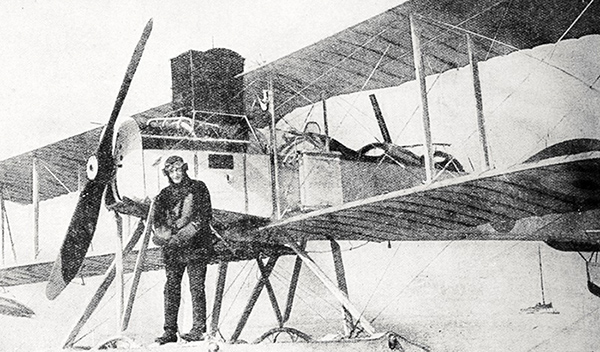 Davenport in flying gear next to a RNAS Short 184 Seaplane.Auckland Weekly News, 27 July 1916, Sir George Grey Special Collections, Auckland Libraries, AWNS-19160727-42-2
Davenport in flying gear next to a RNAS Short 184 Seaplane.Auckland Weekly News, 27 July 1916, Sir George Grey Special Collections, Auckland Libraries, AWNS-19160727-42-2
Davenport gained his pilot or aviator’s certificate on 25 November 1915 and was transferred to the Naval Flying School at Eastchurch in Kent to fine-tune his flying skills. There Davenport met fellow New Zealander Donald Harkness, an engineering student from Canterbury University College. Harkness mentions Davenport a number of times in his wartime diary, describing him as a `very nice fellow’. This entry, dated 29 December 1915, reveals the trials of cross-country flights in fragile planes with limited navigational equipment:
‘Davenport did not return last night as he had lost his way and come down near Canterbury. Today he left there, but owing to engine trouble came down again near Chatham. He turned up here again tonight, but without his machine. He landed near a camp, where a crowd of soldiers gathered round, the great majority of whom he said had never seen an aeroplane before and just gaped open-mouthed’.



